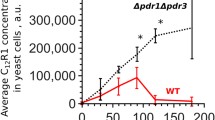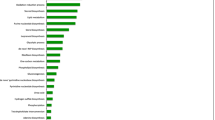Abstract
In Saccharomyces cerevisiae, we have demonstrated that organic solvent stress activated the pleiotropic drug resistance (PDR) pathway, which involves the transcription factors Pdr1p and Pdr3p. Pdr1p and Pdr3p are functionally homologous in multidrug resistance, although Pdr3p has been reported to have some distinct functions. Here, we analyzed the functions of Pdr1p and Pdr3p during the cellular response to isooctane, as a representative of organic solvents, and observed the differential functions of Pdr1p and Pdr3p. In response to organic solvent stress, only Pdr3p contributed to the regulation of downstream genes of the PDR pathway, while Pdr1p had a rather inhibitory role on transcriptional induction through competition with Pdr3p for binding to their recognition sequence, pleiotropic drug response element. Our results demonstrated that organic solvent stress was likely to damage mitochondria, causing generation of reactive oxygen species and mitochondrial fragmentation, and to activate retrograde signaling pathway via Pdr3p to upregulate PDR5 expression. Therefore, the unique function of Pdr3p in organic solvent stress distinguishes this pathway from the multidrug response.







Similar content being viewed by others
Explore related subjects
Discover the latest articles and news from researchers in related subjects, suggested using machine learning.References
Akache B, Turcotte B (2002) New regulators of drug sensitivity in the family of yeast zinc cluster proteins. J Biol Chem 277:21254–21260
Akache B, MacPherson S, Sylvain MA, Turcotte B (2004) Complex interplay among regulators of drug resistance genes in Saccharomyces cerevisiae. J Biol Chem 279:27855–27860
Balzi E, Wang M, Leterme S, Van Dyck L, Goffeau A (1994) PDR5, a novel yeast multidrug resistance conferring transporter controlled by the transcription regulator PDR1. J Biol Chem 269:2206–2214
Borecka-Melkusova S, Kozovska Z, Hikkel I, Dzugasova V, Subik J (2008) RPD3 and ROM2 are required for multidrug resistance in Saccharomyces cerevisiae. FEMS Yeast Res 8:414–424
Carvajal E, van den Hazel HB, Cybularz-Kolaczkowska A, Balzi E, Goffeau A (1997) Molecular and phenotypic characterization of yeast PDR1 mutants that show hyperactive transcription of various ABC multidrug transporter genes. Mol Gen Genet 256:406–415
Delahodde A, Delaveau T, Jacq C (1995) Positive autoregulation of the yeast transcription factor Pdr3p, which is involved in control of drug resistance. Mol Cell Biol 15:4043–4051
Delaveau T, Delahodde A, Carvajal E, Subik J, Jacq C (1994) PDR3, a new yeast regulatory gene, is homologous to PDR1 and controls the multidrug resistance phenomenon. Mol Gen Genet 244:501–511
Devaux F, Carvajal E, Moye-Rowley S, Jacq C (2002) Genome-wide studies on the nuclear PDR3-controlled response to mitochondrial dysfunction in yeast. FEBS Lett 515:25–28
Epstein CB, Waddle JA, Hale W, Dave V, Thornton J, Macatee TL, Garner HR, Butow RA (2001) Genome-wide responses to mitochondrial dysfunction. Mol Biol Cell 12:297–308
Ghaemmaghami S, Huh WK, Bower K, Howson RW, Belle A, Dephoure N, O’Shea EK, Weissman JS (2003) Global analysis of protein expression in yeast. Nature 425:737–741
Gulshan K, Schmidt JA, Shahi P, Moye-Rowley WS (2008) Evidence for the bifunctional nature of mitochondrial phosphatidylserine decarboxylase: role in Pdr3-dependent retrograde regulation of PDR5 expression. Mol Cell Biol 28:5851–5864
Hallstrom TC, Moye-Rowley WS (2000) Multiple signals from dysfunctional mitochondria activate the pleiotropic drug resistance pathway in Saccharomyces cerevisiae. J Biol Chem 275:37347–37356
Hellauer K, Akache B, MacPherson S, Sirard E, Turcotte B (2002) Zinc cluster protein Rdr1p is a transcriptional repressor of the PDR5 gene encoding a multidrug transporter. J Biol Chem 277:17671–17676
Hikkel I, Lucau-Danila A, Delaveau T, Marc P, Devaux F, Jacq C (2003) A general strategy to uncover transcription factor properties identifies a new regulator of drug resistance in yeast. J Biol Chem 278:11427–11432
Jazwinski SM, Kriete A (2012) The yeast retrograde response as a model of intracellular signaling of mitochondrial dysfunction. Front Physiol 3:139
Jungwirth H, Kuchler K (2006) Yeast ABC transporters—a tale of sex, stress, drugs and aging. FEBS Lett 580:1131–1138
Katzmann DJ, Burnett PE, Golin J, Mahe Y, Moye-Rowley WS (1994) Transcriptional control of the yeast PDR5 gene by the PDR3 gene product. Mol Cell Biol 14:4653–4661
Katzmann DJ, Hallstrom TC, Mahe Y, Moye-Rowley WS (1996) Multiple Pdr1p/Pdr3p binding sites are essential for normal expression of the ATP binding cassette transporter protein-encoding gene PDR5. J Biol Chem 271:23049–23054
Kawamoto T, Kanda T, Tanaka A (2001) Preparation of an organic solvent-tolerant strain from baker’s yeast. Appl Microbiol Biotechnol 55:476–479
Larochelle M, Drouin S, Robert F, Turcotte B (2006) Oxidative stress-activated zinc cluster protein Stb5 has dual activator/repressor functions required for pentose phosphate pathway regulation and NADPH production. Mol Cell Biol 26:6690–6701
Le Crom S, Devaux F, Marc P, Zhang X, Moye-Rowley WS, Jacq C (2002) New insights into the pleiotropic drug resistance network from genome-wide characterization of the YRR1 transcription factor regulation system. Mol Cell Biol 22:2642–2649
MacPherson S, Larochelle M, Turcotte B (2006) A fungal family of transcriptional regulators: the zinc cluster proteins. Microbiol Mol Biol Rev 70:583–604
Mamnun YM, Pandjaitan R, Mahe Y, Delahodde A, Kuchler K (2002) The yeast zinc finger regulators Pdr1p and Pdr3p control pleiotropic drug resistance (PDR) as homo- and heterodimers in vivo. Mol Microbiol 46:1429–1440
Matsui K, Teranishi S, Kamon S, Kuroda K, Ueda M (2008) Discovery of a modified transcription factor endowing yeasts with organic-solvent tolerance and reconstruction of an organic-solvent-tolerant Saccharomyces cerevisiae strain. Appl Environ Microbiol 74:4222–4225
Moye-Rowley WS (2003) Transcriptional control of multidrug resistance in the yeast Saccharomyces. Prog Nucleic Acid Res Mol Biol 73:251–279
Moye-Rowley WS (2005) Retrograde regulation of multidrug resistance in Saccharomyces cerevisiae. Gene 354:15–21
Nishida N, Jing D, Kuroda K, Ueda M (2014) Activation of signaling pathways related to cell wall integrity and multidrug resistance by organic solvent in Saccharomyces cerevisiae. Curr Genet 60:149–162
Nourani A, Papajova D, Delahodde A, Jacq C, Subik J (1997) Clustered amino acid substitutions in the yeast transcription regulator Pdr3p increase pleiotropic drug resistance and identify a new central regulatory domain. Mol Gen Genet 256:397–405
Okamoto K, Shaw JM (2005) Mitochondrial morphology and dynamics in yeast and multicellular eukaryotes. Annu Rev Genet 39:503–536
Puig O, Caspary F, Rigaut G, Rutz B, Bouveret E, Bragado-Nilsson E, Wilm M, Seraphin B (2001) The tandem affinity purification (TAP) method: a general procedure of protein complex purification. Methods 24:218–229
Shahi P, Gulshan K, Moye-Rowley WS (2007) Negative transcriptional regulation of multidrug resistance gene expression by an Hsp70 protein. J Biol Chem 282:26822–26831
Shahi P, Gulshan K, Naar AM, Moye-Rowley WS (2010) Differential roles of transcriptional mediator subunits in regulation of multidrug resistance gene expression in Saccharomyces cerevisiae. Mol Biol Cell 21:2469–2482
Sikorski RS, Hieter P (1989) A system of shuttle vectors and yeast host strains designed for efficient manipulation of DNA in Saccharomyces cerevisiae. Genetics 122:19–27
Thakur JK, Arthanari H, Yang F, Pan SJ, Fan X, Breger J, Frueh DP, Gulshan K, Li DK, Mylonakis E, Struhl K, Moye-Rowley WS, Cormack BP, Wagner G, Naar AM (2008) A nuclear receptor-like pathway regulating multidrug resistance in fungi. Nature 452:604–609
Zhang X, Moye-Rowley WS (2001) Saccharomyces cerevisiae multidrug resistance gene expression inversely correlates with the status of the F(0) component of the mitochondrial ATPase. J Biol Chem 276:47844–47852
Zhang X, Cui Z, Miyakawa T, Moye-Rowley WS (2001) Cross-talk between transcriptional regulators of multidrug resistance in Saccharomyces cerevisiae. J Biol Chem 276:8812–8819
Zhang X, Kolaczkowska A, Devaux F, Panwar SL, Hallstrom TC, Jacq C, Moye-Rowley WS (2005) Transcriptional regulation by Lge1p requires a function independent of its role in histone H2B ubiquitination. J Biol Chem 280:2759–2770
Acknowledgments
This work was supported by a Grant-in-Aid for Scientific Research (C) (No. 25450099) and a Grant-in-Aid for JSPS Fellows (No. 243819) from the Japan Society for the Promotion of Science and by the commission for Development of Artificial Genes Synthesis Technology for Creating Innovative Biomaterial from the Ministry of Economy, Trade and Industry (METI), Japan. We are grateful to our colleague, Mr. Y. Tatsukami for contribution to the experiments.
Author information
Authors and Affiliations
Corresponding author
Additional information
Communicated by K. Kuchler.
Rights and permissions
About this article
Cite this article
Nishida-Aoki, N., Mori, H., Kuroda, K. et al. Activation of the mitochondrial signaling pathway in response to organic solvent stress in yeast. Curr Genet 61, 153–164 (2015). https://doi.org/10.1007/s00294-014-0463-9
Received:
Revised:
Accepted:
Published:
Issue Date:
DOI: https://doi.org/10.1007/s00294-014-0463-9




